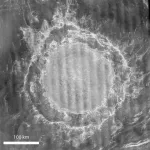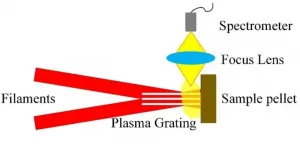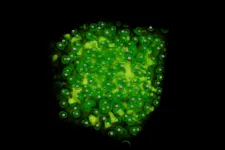(Press-News.org) DURHAM, N.C. -- Malaria is an ancient scourge, but it's still leaving its mark on the human genome. And now, researchers have uncovered recent traces of adaptation to malaria in the DNA of people from Cabo Verde, an island nation off the African coast.
An archipelago of ten islands in the Atlantic Ocean some 385 miles offshore from Senegal, Cabo Verde was uninhabited until the mid-1400s, when it was colonized by Portuguese sailors who brought enslaved Africans with them and forced them to work the land.
The Africans who were forcibly brought to Cabo Verde carried a genetic mutation, which the European colonists lacked, that prevents a type of malaria parasite known as Plasmodium vivax from invading red blood cells. Among malaria parasites, Plasmodium vivax is the most widespread, putting one third of the world's population at risk.
People who subsequently inherited the protective mutation as Africans and Europeans intermingled had such a huge survival advantage that, within just 20 generations, the proportion of islanders carrying it had surged, the researchers report.
Other examples of genetic adaptation in humans are thought to have unfolded over tens to hundreds of thousands of years. But the development of malaria resistance in Cabo Verde took only 500 years.
"That is the blink of an eye on the scale of evolutionary time," said first author Iman Hamid, a Ph.D. student in assistant professor Amy Goldberg's lab at Duke University.
It is unsurprising that a gene that protects from malaria would give people who carry it an evolutionary edge, the researchers said. One of the oldest known diseases, malaria continues to claim up to a million lives each year, most of them children.
The findings, published this month in the journal eLife, represent one of the speediest, most dramatic changes measured in the human genome, says a team led by Goldberg and Sandra Beleza of the University of Leicester.
The researchers analyzed DNA from 563 islanders. Using statistical methods they developed for people with mixed ancestry, they compared the island of Santiago, where malaria has always been a fact of life, with other islands of Cabo Verde, where the disease has been less prevalent.
The team found that the frequency of the protective mutation on Santiago is higher than expected today, given how much of the islanders' ancestry can be traced back to Africa versus Europe.
In other words, the chances of a person surviving and having a family thanks to their genetic code -- the strength of selection -- were so great that the protective variant spread above and beyond the contributions of the Africans who arrived on Santiago's shores. The same was not true elsewhere in the archipelago.
The team's analyses also showed that as the protective mutation spread, nearby stretches of African-like DNA hitchhiked along with it, but only on malaria-plagued Santiago and not on other Cabo Verdean islands.
Together, the results suggest that what they were detecting was the result of adaptation in the recent past, in the few hundred years since the islands were settled, and not merely the lingering imprint of processes that happened long ago in Africa.
Humans are constantly evolving, but evidence of recent genetic adaptation -- during the last 10 to 100 generations -- has been hard to find. Part of the problem is that, on such short timescales, changes in gene frequencies can be hard to detect using traditional statistical methods.
But by using patterns of genetic ancestry to help reconstruct the Cabo Verdean islanders' history, the researchers were able to detect evolutionary changes that previous techniques missed.
The authors hope to extend their methods to study other populations where mass migration means migrants are exposed to different diseases and environments than they were before.
"Humans are still evolving, and here we have evidence," Hamid said.
INFORMATION:
This research was supported by grants from the National Institutes of Health (R35 GM133481, F32 GM139313).
CITATION: "Rapid Adaptation to Malaria Facilitated by Admixture in the Human Population of Cabo Verde," Iman Hamid, Katharine L Korunes, Sandra Beleza, Amy Goldberg. eLife, Jan. 19, 2021. DOI: 10.7554/eLife.63177
CHAPEL HILL, NC - Many molecules in our bodies help our immune system keep us healthy without overreacting so much that our immune cells cause problems, such as autoimmune diseases. One molecule, called AIM2, is part of our innate immunity - a defense system established since birth - to fight pathogens and keep us healthy. But little was known about AIM2's contribution to T cell adaptive immunity - defenses developed in response to particular pathogens and health problems we develop over the course of our lives.
Now, UNC School of Medicine scientists led by Jenny Ting, PhD, the William Kenan Distinguished Professor of Genetics, and Yisong Wan, PhD, professor of microbiology and immunology, discovered that AIM2 is important for the proper function of regulatory ...
DURHAM, N.C. -- When their manhood is threatened, some men respond aggressively, but not all. New research from Duke University suggests who may be most triggered by such threats - younger men whose sense of masculinity depends heavily on other people's opinions.
"Our results suggest that the more social pressure a man feels to be masculine, the more aggressive he may be," said Adam Stanaland, a Ph.D. candidate in psychology and public policy at Duke and the study's lead author.
"When those men feel they are not living up to strict gender norms, they may feel the need to act aggressively to prove their manhood -- to 'be a man'."
The pair of studies considered 195 undergraduate students and a random pool of 391 men ages 18 to 56.
Study participants were asked a series ...
Tiny molecular forces at the surface of water droplets can play a big role in laser output emissions. As the most fundamental matrix of life, water drives numerous essential biological activities, through interactions with biomolecules and organisms. Studying the mechanical effects of water-involved interactions contributes to the understanding of biochemical processes. According to Yu-Cheng Chen, professor of electronic engineering at Nanyang Technological University (NTU), "As water interacts with a surface, the hydrophobicity at the bio-interface mainly determines the mechanical equilibrium ...
PROVIDENCE, R.I. [Brown University] -- At some point between 300 million and 1 billion years ago, a large cosmic object smashed into the planet Venus, leaving a crater more than 170 miles in diameter. A team of Brown University researchers has used that ancient impact scar to explore the possibility that Venus once had Earth-like plate tectonics.
For a study published in Nature Astronomy, the researchers used computer models to recreate the impact that carved out Mead crater, Venus's largest impact basin. Mead is surrounded by two clifflike faults -- rocky ripples frozen in time after the basin-forming impact. The models showed that for those rings to be where they ...
BOSTON-Boston Medical Center has released a study that shows post overdose outreach programs in Massachusetts have expanded across the state, as 44 percent of municipalities reported having such programs available - a majority established since 2015 - to reduce risks for those who survive an overdose. The results are published online in the February 2021 issue of Drug and Alcohol Dependence.
These post-overdose outreach programs leverage collaborations between public health overdose prevention practitioners and public safety organizations (police, fire, EMS) to engage overdose survivors and/or their social networks (family, friends, and acquaintances) at their home one to three days after an overdose. ...
Laser-induced breakdown spectroscopy (LIBS) is a rapid chemical analysis tool. A powerful laser pulse is focused on a sample to create a microplasma. The elemental or molecular emission spectra from that microplasma can be used to determine the elemental composition of the sample.
Compared with more traditional technology, like atomic absorption spectroscopy and inductively coupled plasma optical emission spectroscopy (ICP-OES), LIBS has some unique advantages: no sample pretreatment, simultaneous multi-element detection, and real-time noncontact measurements. These advantages make it suitable for practical analysis of solids, gases, and liquids.
Traditional LIBS and extensions
Traditional ...
The study of warm dense matter helps us understand what is going on inside giant planets, brown dwarfs, and neutron stars. However, this state of matter, which exhibits properties of both solids and plasmas, does not occur naturally on Earth. It can be produced artificially in the lab using large X-ray experiments, albeit only at a small scale and for short periods of time. Theoretical and numerical models are essential to evaluate these experiments, which are impossible to interpret without formulas, algorithms, and simulations. Scientists at the Center for Advanced Systems Understanding (CASUS) at the Helmholtz-Zentrum Dresden-Rossendorf (HZDR) have now developed a method to evaluate such ...
With a powerful enough light, you can see things that people once thought would be impossible. Large-scale light source facilities generate that powerful light, and scientists use it to create more durable materials, build more efficient batteries and computers, and learn more about the natural world.
When it comes to building these massive facilities, space is money. If you can get higher-energy beams of light out of smaller devices, you can save millions on construction costs. Add to that the chance to significantly improve the capabilities of existing light sources, and you have the motivation behind a project that has brought scientists at three U.S. Department of Energy national laboratories together.
This team has just achieved an important milestone ...
Attempts to identify the genetic causes of neuropsychiatric diseases such as post-traumatic stress disorder (PTSD) through large-scale genome-wide analyses have yielded thousands of potential links. The challenge is further complicated by the wide range of symptoms exhibited by those who have PTSD. For instance, does extreme arousal, anger, or irritation experienced by some have the same genetic basis as the tendency to re-experience traumatic events, another symptom of the disorder?
A new study led by researchers at Yale and the University of California-San Diego (UCSD) provides answers to some of these questions and uncovers intriguing genetic similarities between PTSD and other mental health disorders such as anxiety, bipolar disorder, and schizophrenia. ...
Washington, DC - January 28, 2021 - Self swabs and caregiver swabs are effective at detecting multiple pathogens and are just as accurate as those taken by healthcare workers, according to a team of Australian researchers. The research appears in the Journal of Clinical Microbiology, a publication of the American Society for Microbiology.
"Across the range of pathogens and swab types, there was high agreement between results from self- or caregiver swabs and those performed by a healthcare worker, even when different sites were swabbed (e.g. nasopharyngeal vs. nasal)," said principal investigator Joshua Osowicki, BMedSci, MBBS, FRACP, a Pediatric Infectious Diseases physician in the Murdoch Children's Research Institute's ...




